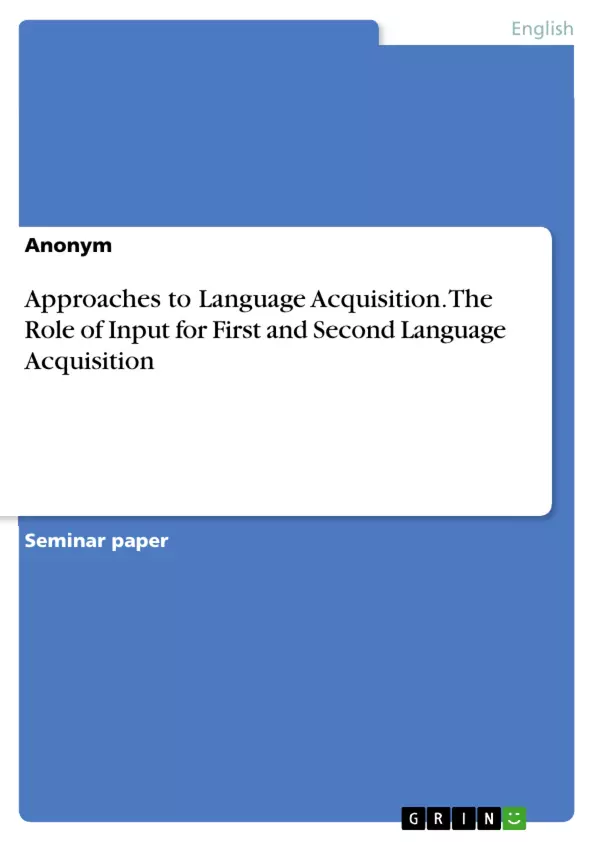The following paper elaborates to what extent input plays a central role in First and Second Language Acquisition and what influence it has in the universal grammar approach to language acquisition and the usage-based approach. Moreover, two papers will be examined and analyzed in the second part of the thesis.
The mastery of one or even more languages can be judged as a necessary foundation of every human being. People’s participation in social processes can only be guaranteed by expressing, interacting and communication trough language. Thus, one can become part of a society by interaction and communication. From birth, infants tend to express themselves, initially through non-verbal communication which is subsequently replaced or extended by single words to first exclamations and incomplete sentences. Thus, as soon as toddlers use more than two words to express themselves, it is often referred to as telegraphic style.
Due to the importance of learning to speak, linguists, psychologists and other scientific field experts have been studying the background and context of language acquisition for quite a long time such as B. F. Skinner who examined language learning already in the 1940s/50s. His sophisticated behavioristic approach, nowadays regarded as outdated, saw the infant as a tabula rasa, i.e., as a kind of blank page which has to be filled or written on. This approach considered the acquisition of language based on a stimulus-response model, in which the environment plays a central role in the learning process. The infant, however, has almost no active role within this process but rather acts as an imitator. Over the years, numerous other theories of language acquisition have been developed and established.
Inhaltsverzeichnis (Table of Contents)
- 1 Introduction
- 2 The Role of Input for First and Second Language Acquisition
- 2.1 Universal Grammar
- 2.2 Usage-Based Approach
- 3 Theoretical Approaches and Analysis
- 3.1 Paper 1: “What infants know about syntax but couldn't have learnt: experimental evidence for syntactic structure at 18 months.”
- 3.2 Paper 2: “Learning antecedents for anaphoric one”
Zielsetzung und Themenschwerpunkte (Objectives and Key Themes)
This paper examines the role of input in first and second language acquisition, analyzing its influence within the universal grammar and usage-based approaches. It further investigates two specific research papers to explore these theoretical frameworks.
- The importance of input in language acquisition.
- Comparison of the universal grammar and usage-based approaches.
- Analysis of empirical research on infant syntax and anaphora.
- The role of the Language Acquisition Device (LAD).
- The limitations of input-based theories.
Zusammenfassung der Kapitel (Chapter Summaries)
Chapter 1: Introduction introduces the significance of language acquisition and provides an overview of the paper's focus on the role of input in both first and second language acquisition. It briefly touches upon contrasting historical perspectives, such as behaviorism.
Chapter 2: The Role of Input for First and Second Language Acquisition discusses the distinction between first and second language acquisition, focusing on the impact of input. It presents arguments for and against the crucial role of input, considering evidence from studies on feral children and the acquisition of grammatical morphemes.
Chapter 3: Theoretical Approaches and Analysis delves into the analysis of two research papers. The first paper explores what infants know about syntax, while the second examines the learning of antecedents for anaphoric "one".
Schlüsselwörter (Keywords)
First language acquisition (FLA), second language acquisition (SLA), input, universal grammar (UG), usage-based approach, Language Acquisition Device (LAD), critical period hypothesis (CPH), infant syntax, anaphora, empirical research.
- Citation du texte
- Anonym (Auteur), 2023, Approaches to Language Acquisition. The Role of Input for First and Second Language Acquisition, Munich, GRIN Verlag, https://www.grin.com/document/1511792



